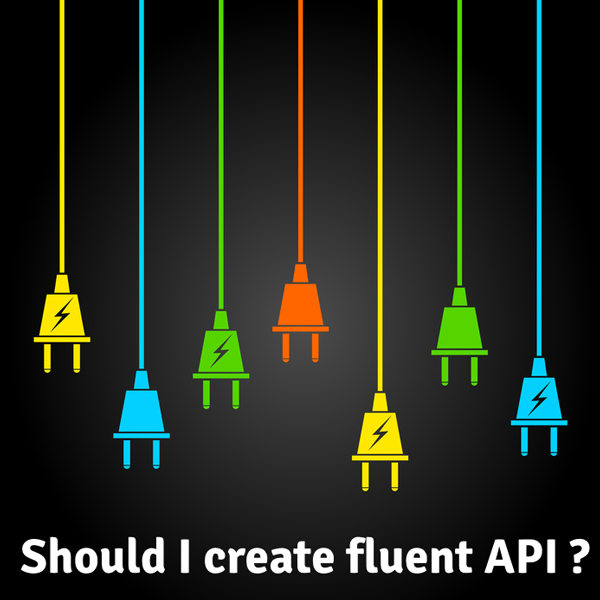JavaScript: Mastering the Art of Fluent APIs
When designing Babylon.js v2.0 (a library for building 3D on the web), I recently found myself wishing for more APIfluent - That said, I want it to be easier for the community to read, Understand and build on your work while spending less time on technical documentation.
In this tutorial, I’ll cover fluent APIs: what to consider, how to Writing them, and the cross-browser performance impact.
What is Fluent API?

The fluent API, as described in this Wikipedia article, is Object-oriented API designed to provide more readable code. JQuery is a great example of what a fluent API allows you to do:
$('<div></div>')
.html("Fluent API are cool!")
.addClass("header")
.appendTo("body");
Smooth API allows you to link The function is called by returning this object.
We can easily create one Fluent API like this:
var MyClass = function(a) {
this.a = a;
}
MyClass.prototype.foo = function(b) {
// Do some complex work
this.a += Math.cos(b);
return this;
}
As you can see, the trick
Just returns the this object (referencing the current instance
in this case) to allow the chain to continue.
If you don’t know How the "this" keyword works in JavaScript, I recommend reading this great article Author of the article: Mike West.
Then we can chain calls:
var obj = new MyClass(5); obj.foo(1).foo(2).foo(3);
Before trying to do the following Same as Babylon.js, I want to make sure this doesn't generate some Performance issues.
How is the performance?
So I did a benchmark test!
var count = 10000000;
var MyClass = function(a) {
this.a = a;
}
MyClass.prototype.foo = function(b) {
// Do some complex work
this.a += Math.cos(b);
return this;
}
MyClass.prototype.foo2 = function (b) {
// Do some complex work
this.a += Math.cos(b);
}
var start = new Date().getTime();
var obj = new MyClass(5);
obj.foo(1).foo(2).foo(3);
for (var index = 0; index < count; index++) {
obj.foo(1).foo(2).foo(3);
}
var end = new Date().getTime();
var start2 = new Date().getTime();
var obj2 = new MyClass(5);
for (var index = 0; index < count; index++) {
obj2.foo2(1);
obj2.foo2(2);
obj2.foo2(3);
}
var end2 = new Date().getTime();
var div = document.getElementById("results");
div.innerHTML += obj.a + ": With return this: " + (end - start) + "ms<BR>";
div.innerHTML += obj2.a + ": Without return this: " + (end2 - start2) + "ms";
as
You can see that foo and foo2 do exactly the same thing. only
The difference is that foo can be linked, while foo2 cannot.
Obviously the call chain The difference is:
obj.foo(1).foo(2).foo(3);
and
obj2.foo2(1); obj2.foo2(2); obj2.foo2(3);
Given this code, I ran it Find out if I care on Chrome, Firefox and IE performance.

This is the result I get:
- On Chrome, the regular API is 6% slower than the Fluent API.
- On Firefox, Both APIs run almost identically (Fluent API is 1% slower).
- On IE, Both APIs run almost identically (Fluent API is 2% slower).
The problem is that I added an operation in the function (Math.cos)
Simulates some kind of processing done by a function.
If I delete everything
Just keep the return statement, it doesn't work on all browsers
The difference (actually only one to two milliseconds over 10,000,000 attempts). you
You can test it yourself across browsers. if you don't have
The device is convenient and there are many free tools on dev.modern.IE. Just don’t perform performance testing on virtual machines
For real devices.
So my conclusion is: come on!
The fluent API is great - it produces more readable code, and you can use it without any issues or performance loss!
More practices JavaScript
This may surprise you a little, but Microsoft There is a lot of free learning content on many open source JavaScript topics, and we are With the arrival of Microsoft Edge, our mission is to create more. Check out my own:
- Introduction to 3D using HTML5 and WebGL Babylon.JS
- Build a single page application using the following commands ASP.NET and AngularJS
- Cutting-edge graphics in HTML
Or our team’s learning series:
- Practical performance tips to make your HTML/JavaScript Faster (a seven-part series from responsive design to Casual games to performance optimization)
- Quick Start with Modern Network Platforms (Basics HTML, CSS and JavaScript)
- Develop universal Windows applications HTML and JavaScript Jump Start (using the JS you've already created Build an application)
Plus some free tools: Visual Studio Community, Azure Trial, and cross-browser testing tools for Mac, Linux, or Windows Windows.
This article is part of network development technology Series from Microsoft. We're excited to share with you Microsoft Edge and the new EdgeHTML rendering engine. free Virtual machine or remote testing on Mac, iOS, Android or Windows devices @http://dev.modern.ie/.
The above is the detailed content of JavaScript: Mastering the Art of Fluent APIs. For more information, please follow other related articles on the PHP Chinese website!

Hot AI Tools

Undresser.AI Undress
AI-powered app for creating realistic nude photos

AI Clothes Remover
Online AI tool for removing clothes from photos.

Undress AI Tool
Undress images for free

Clothoff.io
AI clothes remover

Video Face Swap
Swap faces in any video effortlessly with our completely free AI face swap tool!

Hot Article

Hot Tools

Notepad++7.3.1
Easy-to-use and free code editor

SublimeText3 Chinese version
Chinese version, very easy to use

Zend Studio 13.0.1
Powerful PHP integrated development environment

Dreamweaver CS6
Visual web development tools

SublimeText3 Mac version
God-level code editing software (SublimeText3)

Hot Topics
 What should I do if I encounter garbled code printing for front-end thermal paper receipts?
Apr 04, 2025 pm 02:42 PM
What should I do if I encounter garbled code printing for front-end thermal paper receipts?
Apr 04, 2025 pm 02:42 PM
Frequently Asked Questions and Solutions for Front-end Thermal Paper Ticket Printing In Front-end Development, Ticket Printing is a common requirement. However, many developers are implementing...
 Demystifying JavaScript: What It Does and Why It Matters
Apr 09, 2025 am 12:07 AM
Demystifying JavaScript: What It Does and Why It Matters
Apr 09, 2025 am 12:07 AM
JavaScript is the cornerstone of modern web development, and its main functions include event-driven programming, dynamic content generation and asynchronous programming. 1) Event-driven programming allows web pages to change dynamically according to user operations. 2) Dynamic content generation allows page content to be adjusted according to conditions. 3) Asynchronous programming ensures that the user interface is not blocked. JavaScript is widely used in web interaction, single-page application and server-side development, greatly improving the flexibility of user experience and cross-platform development.
 Who gets paid more Python or JavaScript?
Apr 04, 2025 am 12:09 AM
Who gets paid more Python or JavaScript?
Apr 04, 2025 am 12:09 AM
There is no absolute salary for Python and JavaScript developers, depending on skills and industry needs. 1. Python may be paid more in data science and machine learning. 2. JavaScript has great demand in front-end and full-stack development, and its salary is also considerable. 3. Influencing factors include experience, geographical location, company size and specific skills.
 Is JavaScript hard to learn?
Apr 03, 2025 am 12:20 AM
Is JavaScript hard to learn?
Apr 03, 2025 am 12:20 AM
Learning JavaScript is not difficult, but it is challenging. 1) Understand basic concepts such as variables, data types, functions, etc. 2) Master asynchronous programming and implement it through event loops. 3) Use DOM operations and Promise to handle asynchronous requests. 4) Avoid common mistakes and use debugging techniques. 5) Optimize performance and follow best practices.
 How to merge array elements with the same ID into one object using JavaScript?
Apr 04, 2025 pm 05:09 PM
How to merge array elements with the same ID into one object using JavaScript?
Apr 04, 2025 pm 05:09 PM
How to merge array elements with the same ID into one object in JavaScript? When processing data, we often encounter the need to have the same ID...
 How to achieve parallax scrolling and element animation effects, like Shiseido's official website?
or:
How can we achieve the animation effect accompanied by page scrolling like Shiseido's official website?
Apr 04, 2025 pm 05:36 PM
How to achieve parallax scrolling and element animation effects, like Shiseido's official website?
or:
How can we achieve the animation effect accompanied by page scrolling like Shiseido's official website?
Apr 04, 2025 pm 05:36 PM
Discussion on the realization of parallax scrolling and element animation effects in this article will explore how to achieve similar to Shiseido official website (https://www.shiseido.co.jp/sb/wonderland/)...
 The Evolution of JavaScript: Current Trends and Future Prospects
Apr 10, 2025 am 09:33 AM
The Evolution of JavaScript: Current Trends and Future Prospects
Apr 10, 2025 am 09:33 AM
The latest trends in JavaScript include the rise of TypeScript, the popularity of modern frameworks and libraries, and the application of WebAssembly. Future prospects cover more powerful type systems, the development of server-side JavaScript, the expansion of artificial intelligence and machine learning, and the potential of IoT and edge computing.
 The difference in console.log output result: Why are the two calls different?
Apr 04, 2025 pm 05:12 PM
The difference in console.log output result: Why are the two calls different?
Apr 04, 2025 pm 05:12 PM
In-depth discussion of the root causes of the difference in console.log output. This article will analyze the differences in the output results of console.log function in a piece of code and explain the reasons behind it. �...






